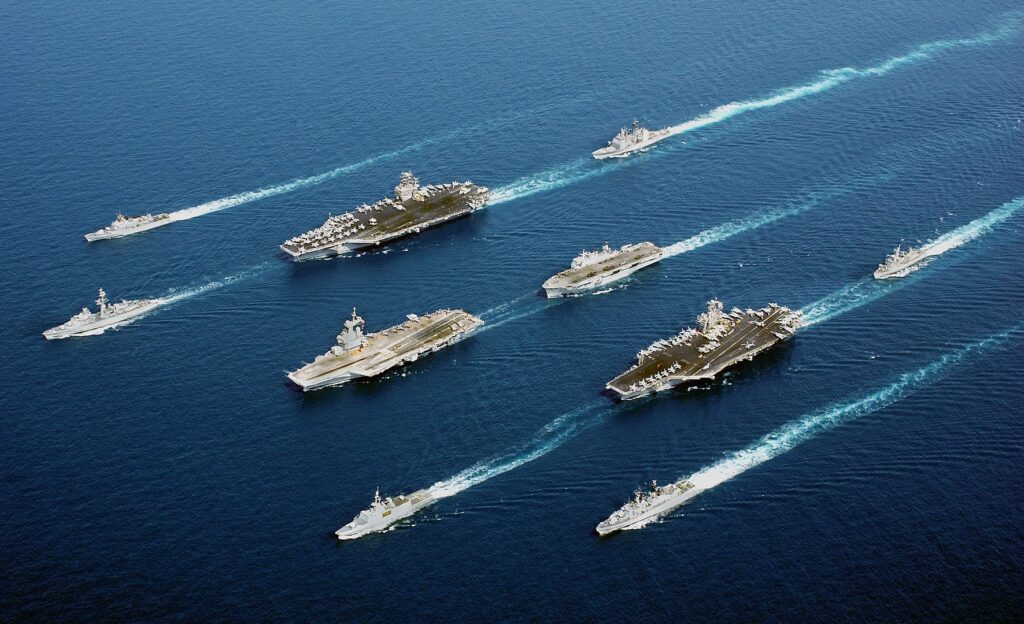
What is an Aircraft Carrier?
A floating, self-propelled airbase. The classification does not include helicopter carriers, and is generally taken to include any vessel capable of handling fixed wing aircraft, of which there are several classifications.
Types of Aircraft Carrier
Except for the very largest carriers, the main classifications are flexible, depending on a country’s typical carrier fleet:
Supercarrier: typically greater than 80,000 tons loaded displacement, usually nuclear powered, with a CATOBAR configuration (configurations are explained below).
Fleet Carrier: mid size 20,000 tons upward, oil/turbine or even diesel powered, the ‘typical’ size in a country’s fleet.
Light Aircraft Carrier: Smaller than the fleet carrier.
Escort Carrier: this classification is obsolete in modern naval fleets.
As can be seen, this way of classifying navy aircraft carriers is subjective to a country’s fleet configuration. The French might well describe the Charles de Gaulle as a supercarrier – steam catapults, nuclear powered, but is it really a supercarrier when compared to say, new aircraft carriers such as the US Gerald R Ford class, more than 100,000 tons displacement and up to 140 fixed wing aircraft?
Indeed, configuration may be a more useful way of classifying aircraft carriers.
Aircraft Carrier Configuration
CATOBAR : catapult launching of fixed wing aircraft (especially ‘fast jet’) but arrested recovery (i.e. arrester gear to stop a plane). Steam catapults are the norm, but electromagnetic catapults are being designed for the next generation.
STOBAR: Short take off but arrested recovery. Typically, these have been using the UK Sea Harrier VTOL aircraft in STOVL mode using a ‘ski jump’, but with the advent of the US JSF (J35), the use of this configuration is likely to increase.
STOVL: Short take off and vertical landing. As with STOBAR, but vertical landing. This configuration is less attractive because of the additional fuel load (equals less armament load) required for the landing phase.
Entry Barriers to the Aircraft Carrier Club
Whilst the proposed new Japanese aircraft carrier, will have a full length flight deck, it may only carry helicopters. The reason for this is related to Japan’s Constitution, which precludes it from developing or owning ships considered to have an offensive capability.
It was only fairly recently that Italy was allowed to fly fixed wing aircraft from its ships as constraints imposed on it at the end of World War 2 were relaxed.
Building the capability to operate and credibly deploy an aircraft carrier as a military asset for the projection of power requires a large investment of time and money, on the political, naval and aerial fronts. A country’s armed forces have to be re-configured and budget profiles changed, which leads to in-fighting between the army, navy and airforce components of the military mix.
Some of the ships and infrastructure requirements can be bought or hired. For example, new or used aircraft carriers may be bought and new aircraft may be sourced from other countries. However, a new branch of naval operations has to be created. This is not trivial – training establishments have to be set up and operated, replenishment, repair and logistics operations have to be established, for example. If a country does eventually not have its own facilities in these regards, then its capability is not credible. This is because, in a time of war one cannot rely on other countries,or overseas commercial companies to provide these facilities.
However, if a lesser role is seen for the carrier in a country’s military doctrine – for example ‘Humanitarian Assistance’ in part, such as Japan espouses, then reliance on external resources is not such an issue. With the PLAN – the People’s Liberation Army Naval Force – now aggressively pursuing the carrier option, Japan may well look for relaxation of fixed wing constraints, and undoubtedly Taiwan will also be looking for carrier capability.
Of course, a country also has to develop its tactical and strategic policies to effectively present and operate its carriers in line with its national strategic objectives.
Even the basic processes of establishing the 24 x 7operational tempo of running a carrier have to be developed, implemented and rehearsed exhaustively if the deployment of a carrier force is to be credible – launching at night in bad weather, crew recovery procedures,anti-submarine measures, aerial defence, coordinated carrier protection – the list is almost endless. Countries do cooperate in this respect. For example there are reports that Brazil is assisting China to develop its operational capability in exchange for technological assistance in the areas of nuclear power and defence electronics.
Aircraft Carriers – The Future
The future of the aircraft carrier seems to be assured. The advent of a new generation of STOVL aircraft, and the emergence of India and China into the serious carrier club(with Pakistan also making noises) means that before the mid 21st century, the carrier arms race will be accelerating. The UK is building bigger carriers – the Queen Elizabeth Class supercarrier. These UK aircraft carriers will be almost three times the size of their previous generation, and ‘cast-off’ carriers are increasingly being bought by smaller nations, so the operational worldwide tonnage is bound to increase – average annual new build tonnage is higher than scrappage; the US is building a new generation – The Gerald R Ford Class.
Electromagnetic launch systems – simpler, lighter, more powerful than steam catapults are being designed. These will be able to launch unmanned aircraft at G forces which a human pilot could not tolerate, and aerial battles fought by unmanned planes flown remotely by carrier-based (o even land-based) jocks via secure data link are a real possibility before the end of the century.
New-concept carrier-busting missiles such as the Chinese Dong Feng 21D are sure to lead to enhanced defensive technology developments.
(c) James Marinero 2011
James Marinero
July 20, 2011



